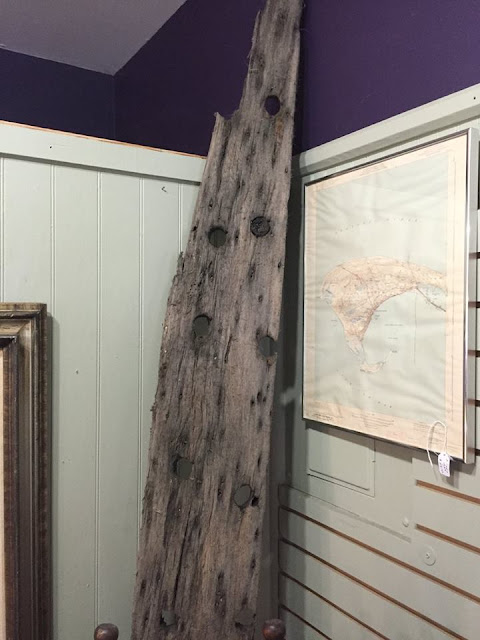Building the Batteau: George Washington’s Mount Vernon
Fisheries
By Luke J. Pecoraro, PhD
Director of Archaeology, George Washington’s Mount Vernon
Upon George Washington’s inheritance of Mount Vernon in the
mid-eighteenth century, his 2,500 acre holding was characterized by a contemporary source as a
“neglected and mediocre plantation” (Walsh, 2001: 54). At pains to keep his estate solvent and also
return a profit, Washington made the bold leap from tobacco monoculture to wheat, experimenting with at
least 60 different crops in addition to fishing the Potomac River. Of all Washington’s economic pursuits
perhaps none were as consistently lucrative as his fisheries; it is estimated that in a spring fishing
season that Washington’s operations netted 1.3 million shad and herring, often accounting for more income
than any one single crop (Walsh 2001: 52).
Both shad and herring were significant food fish in the 18
th century, and at Mount Vernon served both the internal plantation community as well as the broader
Atlantic World (Fig. 1). The fishing operations on the Potomac River generally ran from March through May,
and during this period enslaved laborers worked from dawn to dusk in small watercraft with seine nets
to haul the fish to shore. At the appointed landing sites, the fish would be sorted by species, cleaned,
and either salted and barreled for sale to plantations in the West Indies or smoked and sun-dried for
consumption by the slaves on Washington’s farms (Atkins 1994: 66). Washington stipulated that each
adult slave receive 20 herring per month; during the Revolutionary War when salt was particularly
scarce, Washington’s farm manager informed him:
“…I have but very little salt, of which we must make the
most. I mean to make a brine and after cutting off the head and bellys dipping them in the brine
for but a short time, then hang them up and cure them by smoke, or dry them in the sun; for our
people being so long accustomed to have fish whenever they wanted, would think it very hard to
have none at all…” (Thompson 1999-2002: 19)
Archaeological evidence from Mount Vernon’s House for
Families, a slave quarter near the Mansion House, yielded hundreds of fish bones and the quantities of
shad and herring remains found certainly back up the documentary evidence. What is more, deposits
from the House for Families dating from 1780-1790 indicates that herring was a critical element to
slave diet, perhaps suggesting that Washington intensified his fishing operations during this
period (Bowen et al. 2016: 117).(Fig. 2) Despite what is known of the fisheries at Mount Vernon,
little documentary evidence survives relating to the boats used for this lucrative enterprise. Watercraft
described in Washington’s writings name vessel types such as a schooner, yawl, brigantine, barge, batteau,
and simply “fishing boats”. At least one schooner is thought to have been built by Washington’s
carpenters at Mount Vernon, but the small craft used for fishing seem to have been rented during the spring
from neighboring planters (Walsh 2001: 52).
Mount Vernon had a blacksmith shop and a carpenter shop
which helped to make the plantation reasonably self-sufficient, and it is likely that
Washington’s hired white artisans and enslaved blacksmiths and carpenters built or maintained watercraft
for the fisheries (Fig. 3). In an effort to interpret George Washington’s fisheries, the
historic trades team along with skilled volunteers from the Alexandria, VA boat-building community
is completing the construction of a 21-foot batteau. The batteau is being built on-site at Mount
Vernon’s Pioneer Farm location, using traditional methods and reproduction 18 th century tools (Figs. 4, 5).
The plan of the batteau comes from the collection of plans compiled by Howard I. Chapelle who
served as the curator of maritime history at the Smithsonian Institution from 1957 to 1967. Chapelle’s
drawing of the batteau underway at Mount Vernon comes from his work American Small Sailing Craft
(1936), a formative text that detailed construction of classic American workboats (Fig. 6).
Visitors to Mount Vernon will have the opportunity this summer to visit the craftsmen as they complete the
batteau, in addition to watching the up-to- the-minute process online by visiting mountvernon.org/boatcam.
To learn more about the archaeology program at Mount Vernon and the material recovered, please
visit us at mountvernon.org/preservation/archaeology/.
References
Atkins, Stephen C. 1994 An Archaeological Perspective on the
African-American Slave Diet at Mount Vernon’s House forFamilies. MA Thesis,
Dept. of Anthropology, College of William and Mary. Williamsburg, VA.
Bowen, Joanne, et al. 2016 Faunal Analysis for Mount Vernon:
South Grove Assemblages (44FX762/17), House for Families Assemblages (44FX762/40 and 44FX762/47).
Manuscript prepared for Mount Vernon’s Archaeology Program, Dept. of Historic
Preservation and Collections. Colonial Williamsburg Dept. of Archaeological
Research. Williamsburg, VA.
Thompson, Mary V. 1999-2002 “’Better…fed than Negroes
Generally Are?’: Diet of Mount Vernon Slaves.” Manuscript on file, Mount Vernon
Ladies Association. Mount Vernon, VA.
Walsh, Lorena S. 2001 “Slavery and Agriculture at Mount
Vernon,” in Philip J. Schwarz, editor, Slavery at the Home of George
Washington. Mount Vernon Ladies Association: Mount Vernon, VA. pp. 47-77.
Figure 1:
Approximate locations of George Washington’s fisheries.
Figure 2: fish
bones and scales recovered from the House for Families excavation.
Figure 3: (l) 18th c. compass or dividers in use by the batteau builders, alongside (r) an example recovered archaeologically at Mount Vernon.
Figure 4:
Batteau under construction.
Figure 5:
Replica tools for boat building.
Figure 6:
Chapelle’s 1936 batteau plan.

































